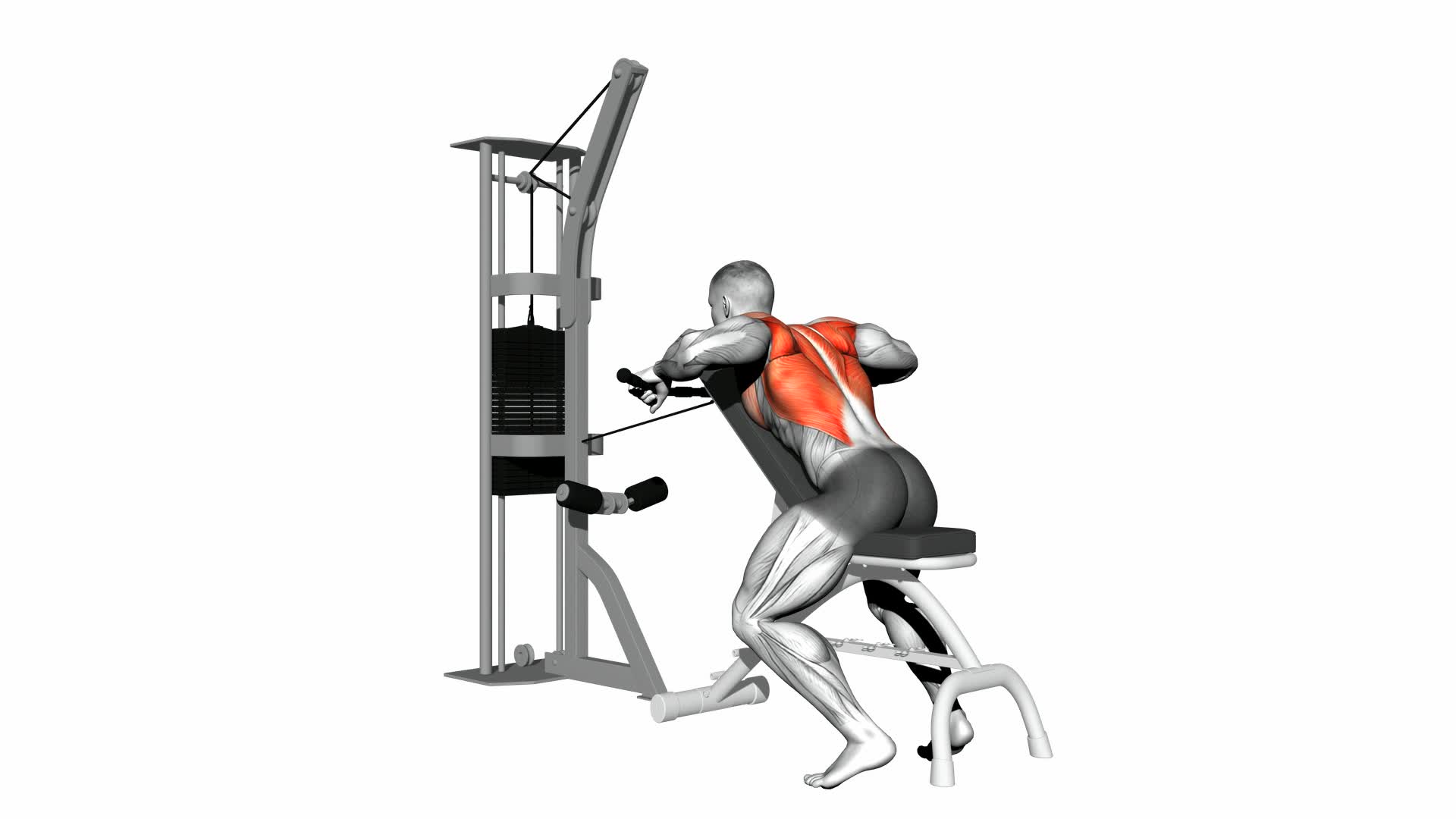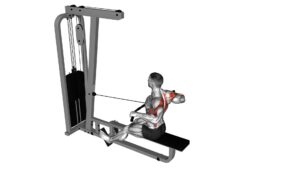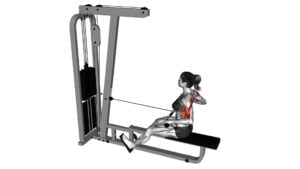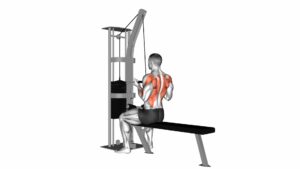Cable Decline Seated Wide-grip Row – Video Exercise Guide & Tips

In this guide, you'll discover the benefits, correct form, variations, and tips for maximizing your cable decline seated wide-grip row workout.
Watch This Exercise Video
With the help of informative videos, you'll learn how to perform this exercise effectively and avoid common mistakes.
Whether you're a beginner or an experienced gym-goer, this article will provide you with the precise information and authoritative guidance you need to get the most out of your cable decline seated wide-grip row.
Key Takeaways
- Cable decline seated wide-grip row increases muscle strength and size.
- This exercise targets multiple muscle groups, including the back, shoulders, and arms.
- Proper form and technique are important for maximizing the benefits and preventing injuries.
- Variations and progressions can be incorporated to challenge the muscles and create a complete workout.
Benefits of Cable Decline Seated Row
You can experience a range of benefits by incorporating the Cable Decline Seated Row into your workout routine. This exercise primarily targets the muscles in your back, including the latissimus dorsi, rhomboids, and rear delts. The cable decline seated row is highly effective in activating these muscles, as it requires you to pull the cable towards your body while maintaining a seated position on a decline bench.
During the cable decline seated row, your back muscles work in unison to perform the pulling motion. This exercise not only strengthens your back muscles but also helps to improve your posture and reduce the risk of back pain. Additionally, the cable decline seated row also engages your biceps and forearms, providing a comprehensive upper body workout.
To progress in cable decline seated row training, you can increase the weight or resistance on the cable machine. This will challenge your muscles and promote growth and strength development. You can also vary your grip width to target different areas of your back. For example, a wide grip emphasizes the outer back muscles, while a close grip targets the inner back muscles.
Incorporating the Cable Decline Seated Row into your workout routine can lead to improved back strength, muscle definition, and overall upper body development. Make sure to maintain proper form and gradually increase the intensity to maximize the benefits of this exercise.
Correct Form for Cable Decline Seated Row
To perform the Cable Decline Seated Row with correct form, start by adjusting the cable machine and positioning yourself on the decline bench. Proper technique for the cable decline seated row is essential to ensure maximum effectiveness and prevent injury.
First, sit on the decline bench facing the cable machine. Adjust the footrest so that your feet are securely placed against it. This will provide stability and support during the exercise.
Next, grab the cable attachments with an overhand grip and sit up straight with your back flat against the bench. Keep your knees slightly bent and maintain a neutral spine throughout the movement.
Begin the exercise by retracting your shoulder blades and pulling the cables towards your lower chest while keeping your elbows close to your body. Focus on squeezing your back muscles as you perform the rowing motion.
The cable decline seated row primarily targets the muscles of your upper back, including the rhomboids, trapezius, and latissimus dorsi. Additionally, it engages the biceps and forearms as secondary muscles.
Remember to maintain control throughout the exercise and avoid using momentum to move the weight. This will ensure that you're effectively targeting the intended muscles and reducing the risk of injury.
Incorporate the proper form and technique for the cable decline seated row into your workout routine to strengthen and develop your back muscles.
Variations and Modifications for Cable Decline Seated Row
There are several variations and modifications available for the cable decline seated row exercise. If you're looking for alternatives to the cable decline seated row, you can try using a resistance band instead of a cable machine. This will provide a similar pulling motion and engage the same muscle groups. Another option is to perform the exercise with dumbbells or a barbell while sitting on a decline bench. This will challenge your muscles in a different way and require more stabilization.
When it comes to equipment needed for cable decline seated row variations, the most important piece is the cable machine itself. This machine typically consists of a weight stack, pulleys, and a cable attachment. Some machines also have adjustable seats and footplates to accommodate different body sizes and positions. Additionally, you may need various attachments such as a wide-grip bar or a V-handle to target different muscles and add variety to your workout.
Common Mistakes to Avoid During Cable Decline Seated Row
One common mistake to avoid during the cable decline seated row is neglecting proper form and technique. When performing this exercise, it's crucial to maintain a stable and upright posture throughout the movement. Many individuals make the mistake of rounding their backs or hunching their shoulders, which not only reduces the effectiveness of the exercise but also puts unnecessary strain on the spine. To avoid this, make sure to keep your chest lifted, shoulders pulled back, and spine neutral.
Another common mistake is using excessive momentum or jerking motions to pull the cable. This not only takes the focus away from the targeted muscles but also increases the risk of injury. Instead, focus on using a slow and controlled movement, emphasizing the contraction of the back muscles.
It is also important to avoid gripping the handles too tightly. This can lead to excessive tension in the forearms and wrists, taking away from the engagement of the back muscles. Instead, use a firm but relaxed grip, allowing the back muscles to do the majority of the work.
Lastly, failing to adjust the cable height can also compromise the effectiveness of the exercise. Make sure that the cable is set at a level that allows for a full range of motion without excessive stretching or straining.
Tips for Maximizing Your Cable Decline Seated Row Workout
Maximize your cable decline seated row workout by incorporating these tips.
If you're looking for alternatives to the cable decline seated row, consider using a barbell or dumbbells. These exercises can target the same muscle groups while offering a slightly different range of motion.
To progress in your cable decline seated row, start by increasing the weight you're lifting. Gradually add more resistance as you become stronger.
Additionally, you can vary your grip width to target different areas of your back muscles. A wider grip will engage your lats more, while a narrower grip will emphasize your rhomboids and middle traps.
Another way to enhance your workout is by implementing drop sets. Start with a heavier weight and perform as many reps as you can. Then, immediately decrease the weight and continue performing more reps until reaching failure. This technique helps to exhaust your muscles and stimulate further growth.
Remember to maintain proper form throughout your workout and focus on contracting your back muscles with each repetition.
Frequently Asked Questions
How Many Calories Can I Burn During a Cable Decline Seated Wide-Grip Row Workout?
During a cable decline seated wide-grip row workout, you can burn a significant amount of calories. This exercise engages multiple muscle groups, including your back, shoulders, and arms, which increases your calorie burn. The more effort you put into the workout, the more calories you'll likely burn.
Additionally, the seated position allows for better stability and focus on targeting the desired muscles. So, make sure to push yourself and maintain proper form to maximize calorie burn and muscle activation.
Can Cable Decline Seated Wide-Grip Rows Help Improve My Posture?
Cable decline seated wide-grip rows can definitely help improve your posture. By engaging the muscles in your upper back and shoulders, this exercise helps to strengthen and stabilize your posture.
The wide grip targets the muscles in your back, promoting proper alignment and reducing the likelihood of slouching.
Incorporating this exercise into your routine regularly can yield significant benefits in terms of posture improvement and overall upper body strength.
Is It Necessary to Use a Wide Grip During Cable Decline Seated Rows, or Can I Use a Different Grip Width?
Using a wide grip during cable decline seated rows offers several benefits for your workout. However, it's not necessary to stick to a wide grip if you prefer a different grip width. Different grip options can target different muscles, providing variety in your routine.
That being said, a wide grip engages the back muscles more effectively, helping to improve posture and build upper body strength. So, while a wide grip is beneficial, feel free to experiment and find the grip width that works best for you.
Can Cable Decline Seated Wide-Grip Rows Help Strengthen My Lower Back Muscles?
Cable decline seated wide-grip rows can definitely help strengthen your lower back muscles. By using a wide grip, you engage more muscles in your back, including your lower back. This exercise is great for targeting those muscles and building strength.
To get the most out of this exercise, make sure to maintain proper form. Keep your back straight, core engaged, and pull the cable towards your belly button, focusing on squeezing your back muscles.
Are There Any Specific Breathing Techniques I Should Follow While Performing Cable Decline Seated Wide-Grip Rows?
When performing cable decline seated wide-grip rows, there are specific breathing techniques you should follow. Proper breathing can enhance the benefits of this exercise.
As you pull the cable towards your body, exhale and engage your core muscles. Inhale as you release the cable and extend your arms. This controlled breathing pattern helps stabilize your body and allows for better muscle activation.
Remember to breathe consistently and rhythmically throughout the exercise for optimal results.
Conclusion
In conclusion, the Cable Decline Seated Row is an effective exercise for targeting your back muscles and improving overall strength.
By maintaining correct form and avoiding common mistakes, you can maximize the benefits of this workout.
Don't forget to try different variations and modifications to keep challenging your muscles.
With proper execution and consistent training, you'll see great results with the Cable Decline Seated Row.

Author
Years ago, the spark of my life’s passion ignited in my mind the moment I stepped into the local gym for the first time. The inaugural bead of perspiration, the initial endeavor, the very first surge of endorphins, and a sense of pride that washed over me post-workout marked the beginning of my deep-seated interest in strength sports, fitness, and sports nutrition. This very curiosity blossomed rapidly into a profound fascination, propelling me to earn a Master’s degree in Physical Education from the Academy of Physical Education in Krakow, followed by a Sports Manager diploma from the Jagiellonian University. My journey of growth led me to gain more specialized qualifications, such as being a certified personal trainer with a focus on sports dietetics, a lifeguard, and an instructor for wellness and corrective gymnastics. Theoretical knowledge paired seamlessly with practical experience, reinforcing my belief that the transformation of individuals under my guidance was also a reflection of my personal growth. This belief holds true even today. Each day, I strive to push the boundaries and explore new realms. These realms gently elevate me to greater heights. The unique combination of passion for my field and the continuous quest for growth fuels my drive to break new ground.







